AUDI R8 SPYDER 2014 Owners Manual
Manufacturer: AUDI, Model Year: 2014, Model line: R8 SPYDER, Model: AUDI R8 SPYDER 2014Pages: 244, PDF Size: 61.06 MB
Page 101 of 244
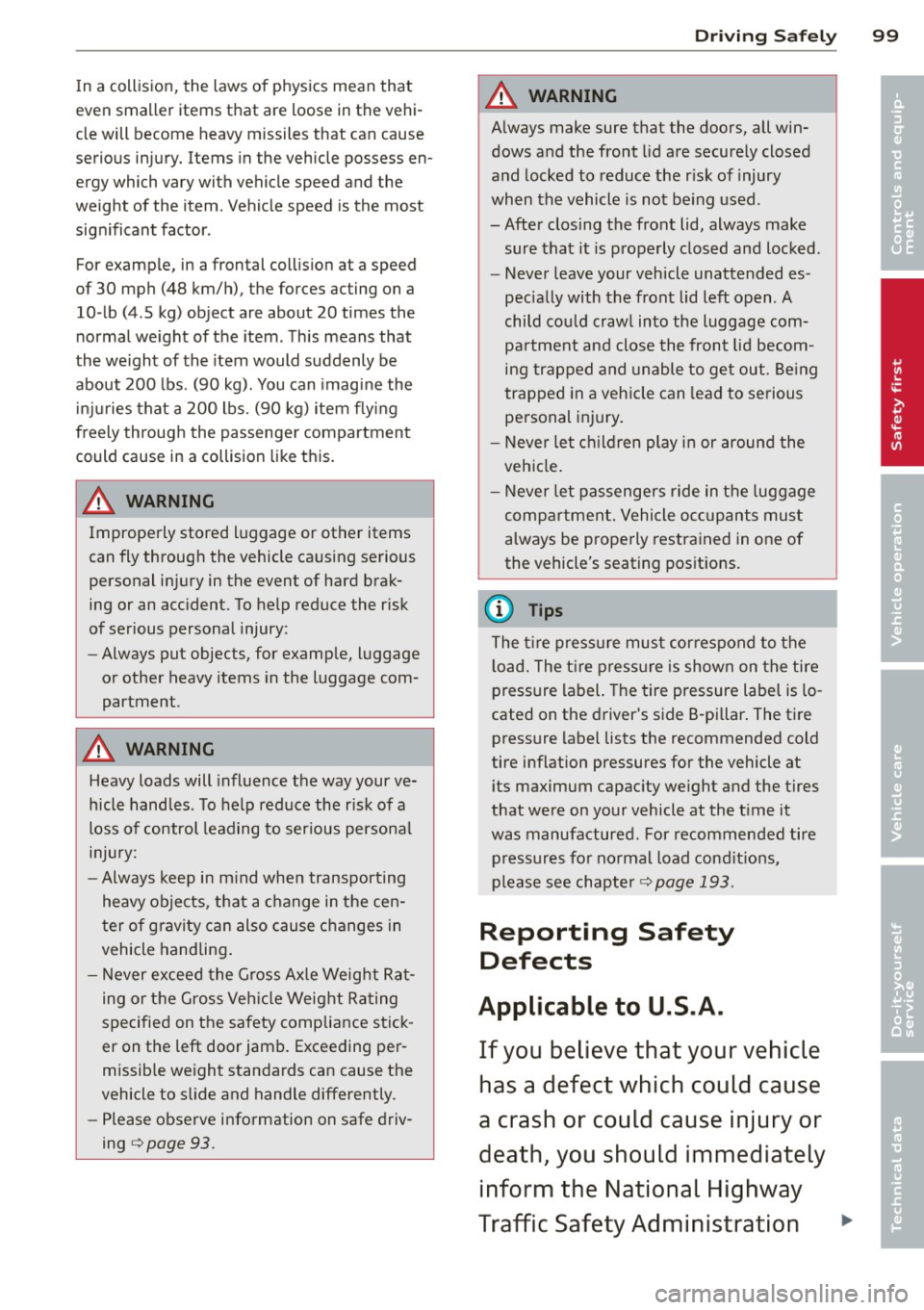
In a collision, the laws of physics mean that
even smaller items that are loose in the ve hi
cle will become heavy missiles that can cause
serious injury. Items in the vehicle possess en
ergy which vary with vehicle speed and the
weight of the item . Vehicle speed is the most
sig nificant factor.
For examp le, in a frontal coll is ion at a speed
of 30 mph (48 km/h), the forces acting on a
10 -lb (4 .5 kg) object are about 20 times the
norma l we ight of the item. Th is means that
the we ight of the item would suddenly be
about 200 lbs. (90 kg). You can imag ine the
in ju ries that a 200 lbs. (90 kg) item flyi ng
freely th roug h the passenge r compartment
could cause in a collision like this.
~ WARNING
Improperly stored luggage or other items
can fly through the vehicle ca us ing serious
personal in jury in the event of hard brak
ing or an acc ident. To help reduce the risk
of serious personal injury :
-Always put objects, for examp le, luggage
or other heavy items in the luggage com
partment .
A WARNING
Heavy loads will influence the way your ve
hicle handles . T o help reduce the r is k of a
loss of control leading to ser ious personal
injury:
- Always keep i n m ind whe n transporting
heavy objects, that a c hange in t he cen
t er of g ravity c an also cause c hanges in
vehicle handling .
- Never exceed the G ross Ax le Weight R at
ing or the Gross Veh icle Weight R ating
specified on t he safety compliance s tic k
er on the left door jamb. Exceeding pe r
missib le we ight standa rds can cause the
vehicle to s lide and handle differently.
- Please obse rve info rmation on safe driv
ing
c:;, page 93 .
Dr iving S afel y 99
A WARNING
Always make sure that the doors, all win
dows a nd the front lid are secure ly closed
and locked to reduce the r is k of injury
when the vehicle is not be ing used .
- After closing the front lid, always make sure that it is p rope rly closed and locked .
- Never leave your veh icle unattended es
pecially with the front lid left open . A
child co uld craw l into the luggage com
pa rtment and close the front lid becom
ing tr apped and unable to ge t out. Being
trapped in a veh icle can lead to se rious
pe rsonal injury .
- Never let c hild ren play i n or aroun d the
veh icle .
- Never let p assenger s ride in the luggage
comp artment. Vehicle oc cupants mus t
always be prope rly restrained in one of
the vehicle's seating pos it ions .
(D Tips
The t ire press ure mu st cor respond to t he
l oad. The t ire p ress ure is shown on the tire
pressure label. The tire pressure labe l is lo
cated on the d river's side B-pi llar . The t ire
pressure label lists the recommended cold
tire inflation pressures for the vehicle at i ts maximum capac ity we ight and the tires
that we re on your vehicle at the t ime it
was manufactured. For recommended tire
p ressures fo r no rma l load cond it ions,
please see chapter
c:;, page 193.
Reporting Safety
Defects
Applicable to U.S.A.
If you belie ve that your vehi cle
has a d efe ct which could cau se
a crash or could caus e injur y or
d eath, you should immediat ely
inform th e National High way
Tr affi c Safet y Administration
•
•
Page 102 of 244
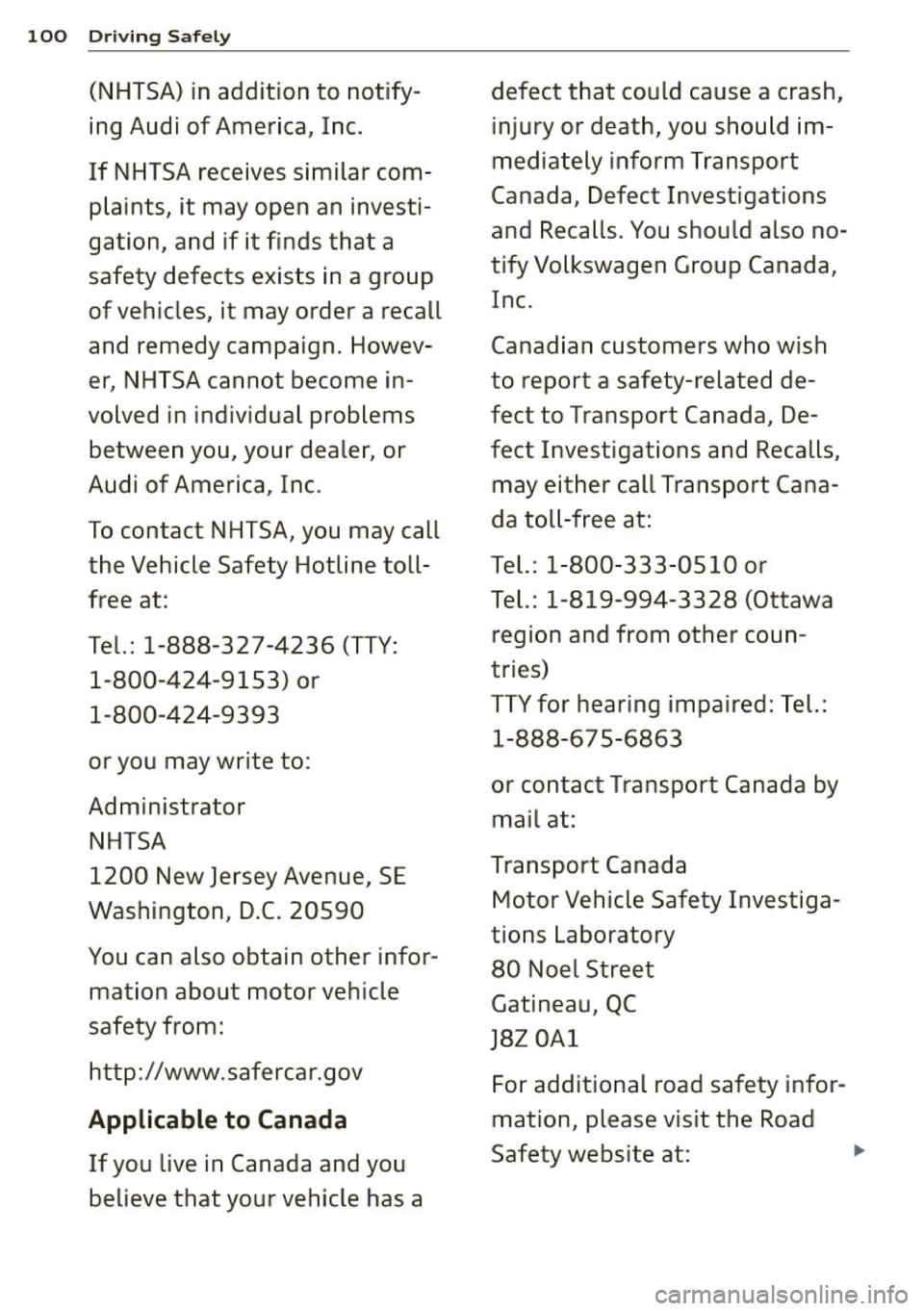
100 Driving Safely
(NHTSA) in addition to notify- defect that could cause a crash,
ing Audi of America, Inc. injury or death, you should im-
If NHTSA receives similar com -mediately inform Transport
plaints, it may open an investi- Canada, Defect Investigations
gation, and if it finds that a and Recalls. You should also no-
tify Volkswagen Group Canada,
safety defects exists in a group
of vehicles, it may order a recall Inc.
and remedy campaign. Howev- Canadian customers who wish
er, NHTSA cannot become in- to report a safety-related de-
valved in individual problems feet to Transport Canada, De-
between you, your dealer, or feet Investigations and Recalls,
Audi of America, Inc. may either call Transport Cana-
To contact NHTSA, you may call da toll-free at:
the Vehicle Safety Hotline toll- Tel.: 1-800 -333 -0510 or
free at: Tel.: 1-819-994-3328 (Ottawa
Tel.: 1-888-327-4236 (TTY: region and from other coun-
1-800-424-9153) or tries)
1-800-424-9 3 9 3 TTY for hear
ing impaired: Tel.:
1 -888-67 5-6863
or you may write to:
Administrator or contact Transport Canada by
mail at:
NHTSA
1200 New Jersey Avenue, SE Transport Canada
Motor Vehicle Safety Investiga-
Washington, D.C. 20590
tions Laboratory
You can also obtain other infor- 80 Noel Street
mation about motor vehicle Gatineau, QC
safety from: )82 OAl
http://www.safercar.gov For additional road safety infor-
Applicable to Canada mation, please visit the Road
If you live in Canada and you Safety website at:
..
believe that your vehicle has a
Page 103 of 244

http ://www .tc.gc.ca/eng/
ro ad safety/me nu.htm
Active rollover
protection system
Function
The active rollover protection system helps
protect vehicle occupants in the event of a rollover.
Fig. 104 Rollbar deployme nt range
Fig . 105 Rollbar deploye d
The active rollover protection system consists
of:
- two rollbars
- the safety belts with belt tens ioners
- th e windshield frame
- the rollover sensors .
The active rollover protection system provides
additional safety in the event of a rollover.
With in milliseconds, sensors deploy two roll
bars located behind the headrests
c> fig. 105.
The rollbars, reinforced windshield frame and
belt tensioners help protect vehicle occupants
in the event of a rollover.
Driving Safely 101
The rollover protection system functions
when the convertible top is both open and
closed.
_& WARNING
Do not use the area behind the headrests
c> fig. 104 as a storage area. This is the
area where the rollbars deploy. If the roll
over protection system is triggered, ob
jects placed there can be propelled
through the vehicle and make it more diffi
cult for the rollbars to deploy. This increas
es the risk for serious or life-threatening
injuries.
When is rollover protection deployed?
Rollover protection deploys in a collision or
rollover.
Depend ing on the collision, sensors through
out the vehicle and the control module trigger
the rollover system to deploy.
For safety reasons, rollover protection also de
ploys during front, side and rear collisions
above a certain level of sever ity.
Page 104 of 244
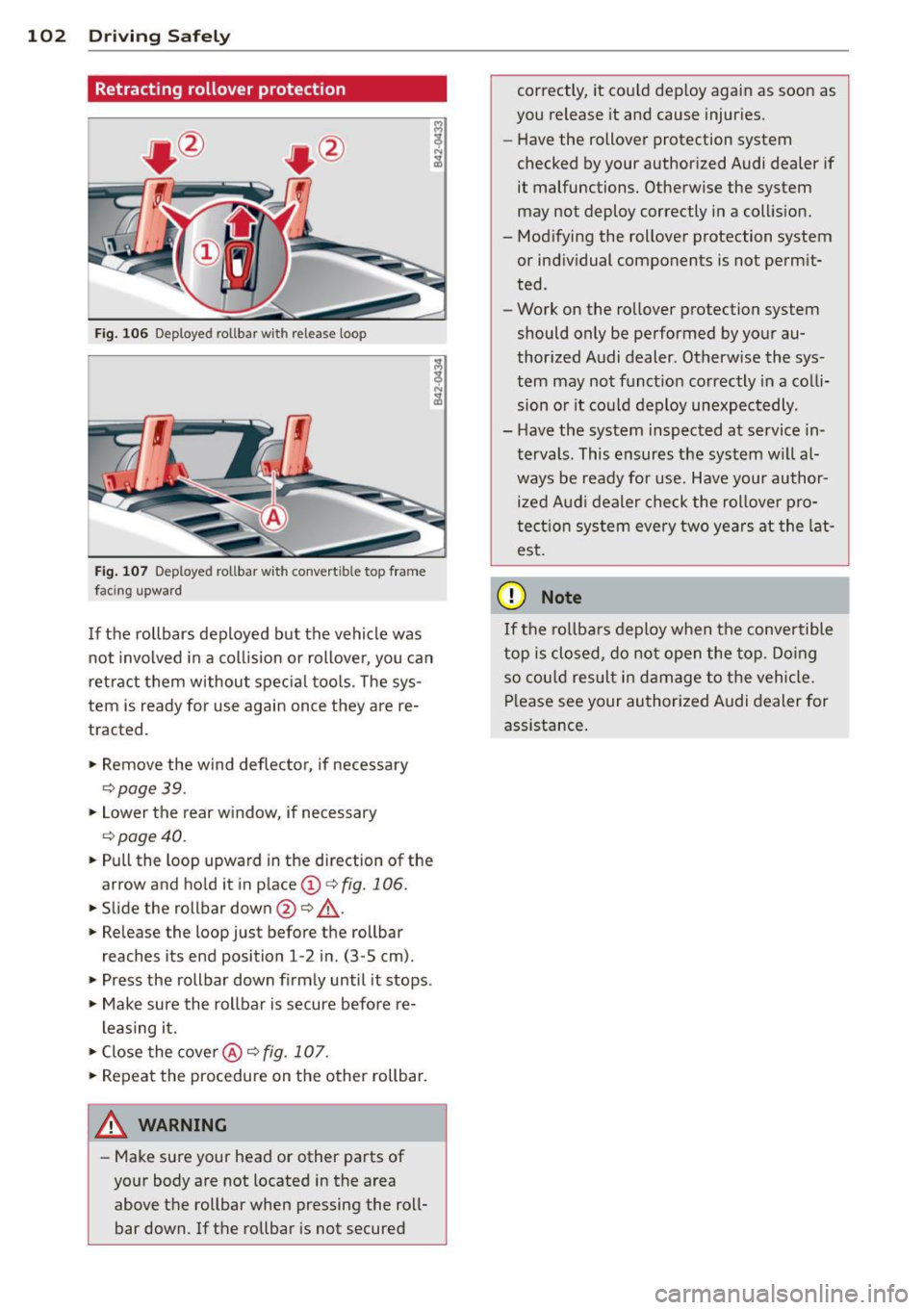
102 Driving Safel y
Retracting rollover protection
Fig. 106 Deployed roll bar w it h release loop
Fig . 107 Dep loye d rollbar w it h convert ible top frame
fac in g upwa rd
If the rollbars deployed but the vehicle was
not involved in a collision or rollover, you can
retract them without spec ia l tools. The sys
tem is ready for use again once they are re
tracted .
.,. Remove the w ind deflec to r, if necessary
c> page39 .
.,. Lower the rear window, if necessary
c> page40 .
.,. Pull the loop upward in the direction of the
arrow and ho ld it in p lace
(I) <=> fig. 106 .
.,. Slide the rollbar down@ c> /1. .
.,. Re lease the loop just before the rollbar
reaches its end position 1-2 i n. (3-5 cm) .
.,. Press the rollbar down firmly until it stops .
.,. Make sure the rollbar is secure before re
leas ing it .
.,. Close the cove r@ c>
fig. 107 .
.,. Repeat the procedure on t he other rollbar.
A WARNING
- Make su re your head or other parts of
yo ur body are not located in the area
above the rollbar when pressing the roll
bar down. If the rollbar is not secured -
correctly, it cou ld dep loy again as soon as
you release it and cause injur ies.
- Have the rollover protection system
checked by your author ized Audi dealer if
it malfunctions. Otherwise the system
may not deploy correctly in a collis ion.
- Mod ifying the rollover protection system
or individual components is not pe rm it
ted .
- Work on the ro llover protection system
should only be performed by your au
thor ized Audi dealer. Otherw ise the sys
tem may not f unct ion co rrectly in a colli
sion o r it co uld deploy unexpectedly.
- Have the system inspected at service in
tervals . This ensures the system w ill al
ways be ready for use. Have your author
i z ed Aud i dealer check the rollover pro
tec tion sys tem every two years at the lat
est.
(D Note
If the ro llba rs deploy when the convertible
top is clo sed, do no t open the top. Do ing
so cou ld resul t in damage to the vehicle.
P lease see your authorized A udi dealer for
ass istance.
Page 105 of 244
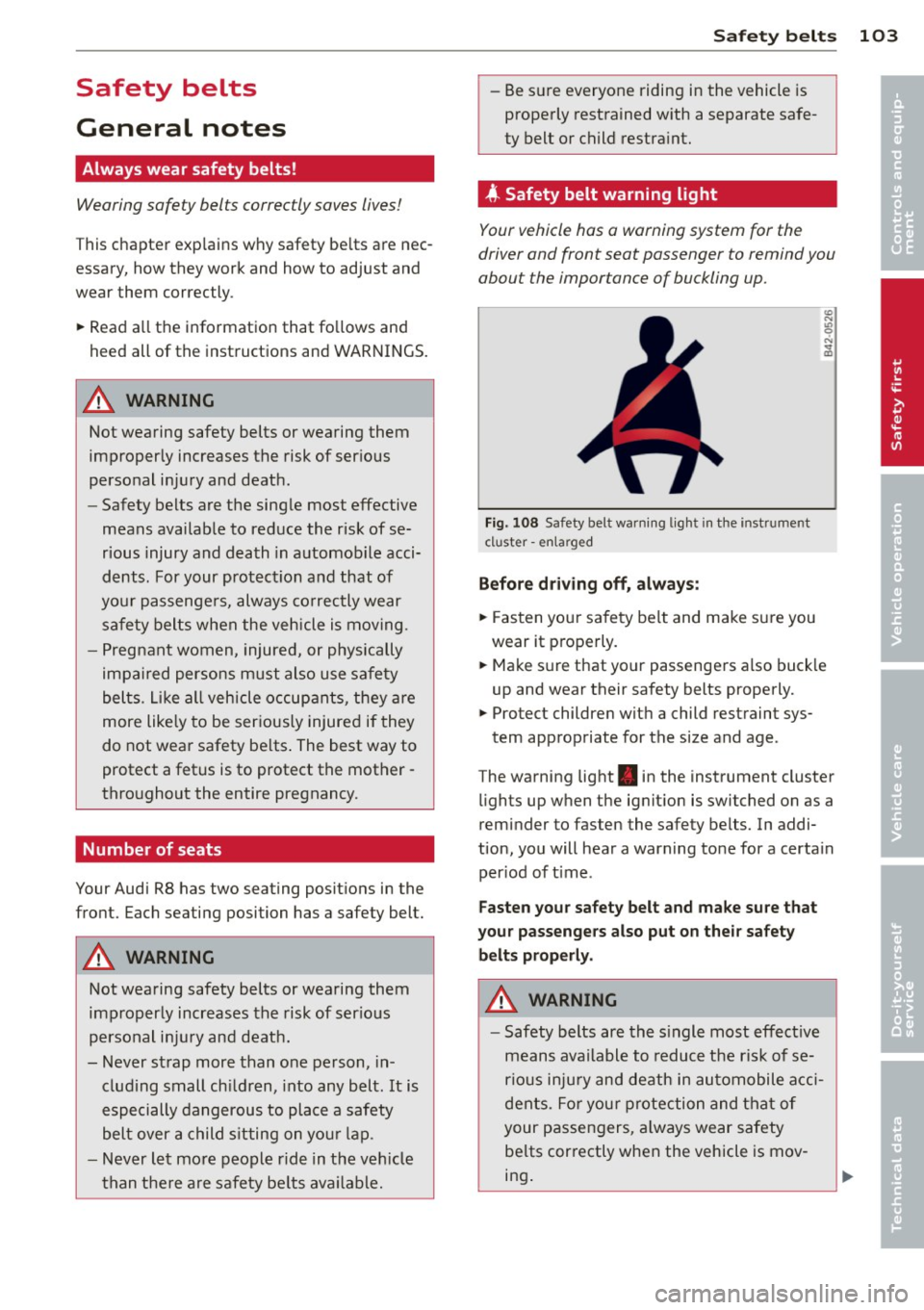
Safety belts
General notes
Always wear safety belts!
Wearing safety belts correctly saves lives!
This chapte r exp lains why safety be lts a re nec
essary, how they work and how to adjust and
wear them correctly.
~ Read a ll the informat ion that fo llows and
heed all of the inst ruct ions and WARNINGS.
A WARNING
Not wearing safety belts or wearing them
improperly increases the risk of ser ious
personal in jury and death .
- Safety belts are the sing le most effective
means availab le to red uce the r isk of se
rious injury and death in a utomob ile acci
de nts . For your prot ecti on and that of
yo ur passenge rs, always co rrec tly wear
sa fe ty bel ts when the ve hicle is mov ing.
- P re g nant women, injured, or physically
imp aired perso ns must also use safe ty
belts. L ike a ll vehicle occup ants, they are
more like ly to be ser ious ly injure d if they
do not wea r safety be lts . The best way to
protect a fet us is to protect the mother -
thro ughout the entire pregnancy.
Number of seats
Your Audi R8 has two seating posit ions in the
front. Each seating position has a safety belt.
A WARNING
Not wearing safety belts or wearing them
im proper ly increases the risk of ser ious
personal in ju ry and death.
- Never st rap more than one person, in
clu ding small ch ild ren, into any belt. It is
especially dangerous to place a safety
belt over a child s itting on yo ur lap.
- Never let mo re people ride in the ve hicle
t h an t he re are safety be lts ava ilable.
Sa fety belts 103
- Be s ure everyone riding in the vehicle is
properly restrained w ith a separate sa fe
ty belt or child restra int.
4 Safety belt warning light
Your vehicle has a warning system for the
driver and front seat passenger to remind you
about the importance of buckling up .
Fig. 1 08 Safety be lt warn ing lig ht in the instr ume nt
cl uster -enla rged
Befor e driv ing off, always :
~ Fasten your sa fe ty belt and make su re you
wear it p roperly.
~ Make s ure that yo ur passenge rs a lso buck le
up and wear their safety belts properly.
~ Protect children with a child rest raint sys-
tem appropriate for the size and age .
The wa rning light . in the inst rument cluster
li ghts up w hen t he ig nit ion is switched on as a
remi nder to fasten the safety belts. In addi
tion , you will hear a warning tone for a certa in
per iod of t ime .
Fasten your safety belt and make sure that
your passengers also put on the ir safety
belts proper ly.
A WARNING
- Safety b elts are the s ingle most effect ive
means ava ilable to reduce t he risk of se
r io us inju ry and death in au tomobile a cci
dents. Fo r yo ur protecti on and tha t of
your passengers, a lways wear safety
be lts cor rectly when the vehicle is mov
ing . •
•
Page 106 of 244
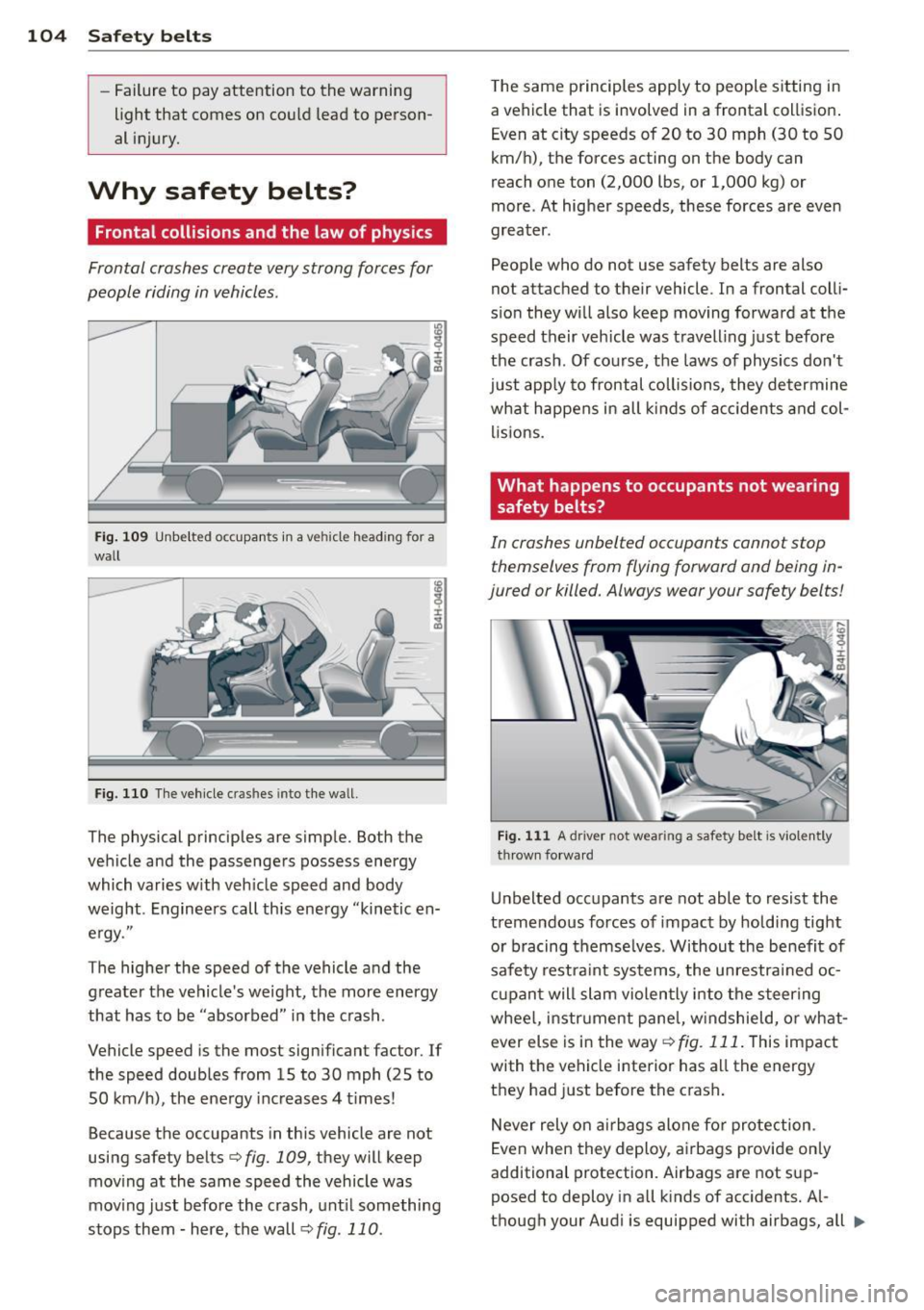
104 Safet y belt s
-Failure to pay attention to the warning
light that comes on could lead to person
al injury.
Why safety belts?
Frontal collisions and the law of physics
Frontal crashes create very strong forces for
people riding in vehicles.
F ig. 10 9 Unbelted occupants in a ve hicle h eading for a
wall
Fig. 110 T he vehicle c rash es into the wa ll.
The physical principles are simple. Both the
vehicle and the passengers possess energy
which varies w ith veh icle speed and body
weight . Engineers call this energy "kinetic en
e rgy ."
The higher the speed of the vehicle and the
g reater the vehicle 's we ight, the more energy
that has to be "absorbed" in the crash .
Vehicle speed is the most sign ificant factor.
If
the speed doubles from 15 to 30 mph (25 to
50 km/h), the ene rgy inc reases 4 t imes!
Because the occupants in this vehicle are not
using safety belts¢
fig. 109, they will keep
mov ing at the same speed the vehicle was
mov ing just before the c rash, unt il something
stops them - here, the wall ¢
fig. 110 .
The same principles apply to people sitting in
a vehicle that is involved in a frontal collision .
Even at c ity speeds of 20 to 30 mph (30 to 50
km/h), the forces acting on the body can
reach one ton (2,000 lbs , or 1,000 kg) or
more . At higher speeds, these forces are even
greater .
Peop le who do not use safety belts are also
not attached to their vehicle. In a frontal coll i
s io n they wi ll also keep moving forward at the
speed their veh icle was t ravell ing just before
the crash . Of co urse, the laws of physics don't
just app ly to frontal collisions, they determine
wh at h appens i n all kinds of a ccidents and col
lisions .
What happens to occupants not wearing
safety belts?
In crashes unbelted occupants cannot stop
themselves from flying forward and being in
jured or killed. Always wear your safety belts!
F ig . 111 A d river not wea ring a safety b elt is viol en tly
thrown fo rwa rd
Unbelted occupants are not able to resist the
t reme ndous forces of impact by holding tight
or b racing themse lves . Withou t the benefit of
safety restr aint sys tems, the unrestra ined oc
cu pan t will slam violen tly into the steering
whee l, instr ument panel, w indshield, or what
ever else is i n the way
.!> fig. 111 . This impact
with the vehicle i nterior has a ll the energy
they had just before the crash .
Never rely on a irbags alone fo r protection .
Even when they deploy , a irbags provide on ly
additional protection . Airbags are not sup
posed to deploy in all k inds of accidents. Al
t h ough your Audi is equipped with airbags, all ..,
Page 107 of 244
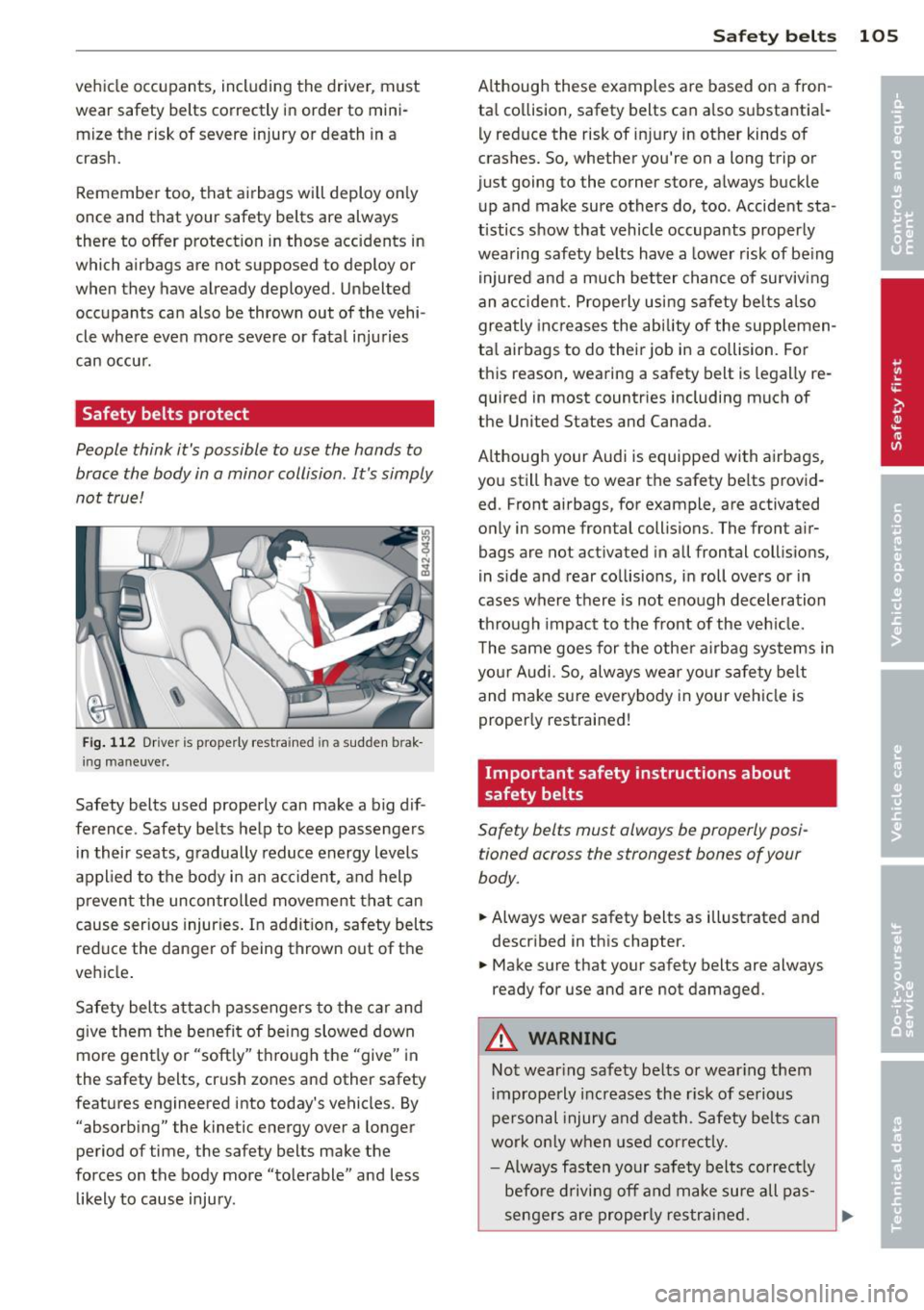
vehicle occupants, including the driver, must
wear safety belts correctly in order to mini
mize the risk of severe injury or death in a
crash.
Remember too, that airbags will deploy on ly
once and that your safety belts are always
there to offer protection in those accidents in
which airbags are not supposed to deploy or
when they have already deployed . Unbelted
occupants can also be thrown out of the vehi
cle where even more severe or fatal injuries
can occur .
Safety belts protect
People think it's possible to use the hands to
brace the body in a minor collision . It's simply
not true!
Fig. 112 Drive r is properly restrained in a sudden b rak
ing maneuve r.
Safety belts used properly can make a big dif
ference . Safety belts help to keep passengers
in their seats, gradually reduce energy levels
applied to the body in an accident, and help
prevent the uncontrolled movement that can
cause serious injuries. In addition, safety belts
reduce the danger of being thrown out of the
vehicle.
Safety belts attach passengers to the car and
give them the benefit of being slowed down
more gently or "softly" through the "give" in
the safety belts, crush zones and other safety
features engineered into today's vehicles . By
"absorbing" the kinetic energy over a longer
period of time, the safety belts make the
forces on the body more "tolerable" and less
likely to cause injury.
Safety belts 105
Although these examples are based on a fron
tal collision, safety belts can also su bsta ntia l
ly reduce the risk of injury in other kinds of
crashes. So, whether you're on a long trip or
just going to the corner store, always buckle up and make sure others do, too . Accident sta
tistics show that vehicle occupants properly
wearing safety belts have a lower risk of being
injured and a much better chance of surviving
an accident. Properly using safety belts also
greatly increases the ability of the supplemen
tal airbags to do their job in a collision. For
this reason, wearing a safety belt is legally re
quired in most countries including much of
the United States and Canada.
Although your Audi is equipped with airbags,
you still have to wear the safety belts provid
ed . Front airbags, for example, are activated
only in some frontal collisions . The front air
bags are not activated in all frontal collisions,
in side and rear collisions, in roll overs or in
cases where there is not enough deceleration
through impact to the front of the vehicle.
The same goes for the other airbag systems in
your Audi. So, always wear your safety belt
and make sure everybody in your vehicle is
properly restrained!
Important safety instructions about
safety belts
Safety belts must always be properly posi
tioned across the strongest bones of your
body.
.,. Always wear safety belts as illustrated and
described in this chapter.
.,. Make sure that your safety belts are always
ready for use and are not damaged.
A WARNING
Not wearing safety belts or wear ing them
improperly increases the risk of serious
personal injury and death. Safety belts can
work only when used correctly.
- Always fasten your safety belts correctly
before driving
off and make sure all pas-
sengers are properly restrained. .,.
Page 108 of 244
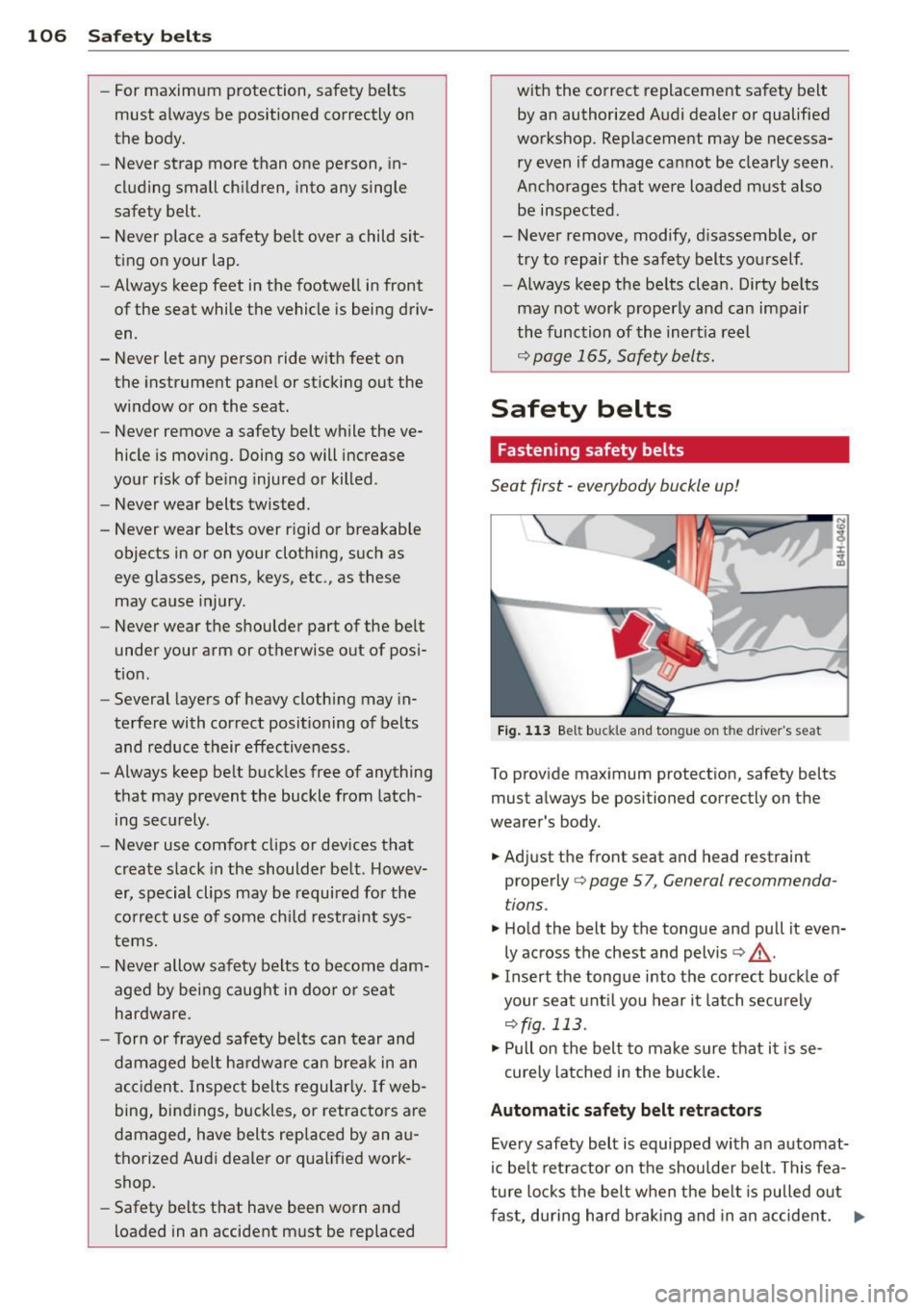
106 Safety belts
-For maximum protection, safety belts
must always be positioned correctly on
the body.
- Never strap more than one person, in
cluding small children, into any single
safety belt.
- Never place a safety belt over a child sit
ting on your lap.
- Always keep feet in the footwell in front
of the seat while the vehicle is being driv
en .
- Never let any person ride with feet on
the instrument panel or sticking out the
window or on the seat.
- Never remove a safety belt while the ve
hicle is moving. Doing so will increase
your risk of be ing injured or killed.
- Never wear belts twisted.
- Never wear belts over rigid or breakable
objects in or on your clothing, such as
eye glasses, pens, keys, etc., as these
may cause injury.
- Never wear the shoulder part of the belt
under your arm or otherwise out of posi
t ion .
- Several layers of heavy clothing may in
terfere with correct positioning of belts and reduce their effectiveness .
- Always keep belt buckles free of anything
that may prevent the buckle from latch
ing securely .
- Never use comfort clips or devices that
create slack in the shoulder belt. Howev
er, special clips may be required for the
correct use of some child restraint sys
tems.
- Never allow safety belts to become dam
aged by being caught in door or seat hardware.
- Torn or frayed safety bel ts can tear and
damaged belt hardware can break in an
accident. Inspect belts regularly. If web
bing, bindings, buckles, or retractors are
damaged, have belts replaced by an au
thorized Audi dealer or qualified work shop.
- Safety belts that have been worn and
loaded in an accident must be replaced with the correct replacement safety belt
by an authorized Audi dealer or qualified
workshop. Replacement may be necessa
ry even if damage cannot be clearly seen .
Anchorages that were loaded must also
be inspected .
- Never remove, modify, disassemble, or
try to repair the safety belts yourself.
- Always keep the belts clean. Dirty belts
may not work properly and can impair
the function of the inertia reel
¢ page 165, Safety belts.
Safety belts
· Fastening safety belts
Seat first -everybody buckle up!
Fig. 113 Be lt buck le and to ngue o n th e drive r's se at
To provide maximum protection, safety belts
must always be positioned correctly on the
wearer 's body.
.. Adjust the front seat and head restraint
properly ¢
page 5 7, General recommenda
t ions .
.. Hold the belt by the tongue and pull it even
ly across the chest and pelvis ¢
_&..
.. Insert the tongue into the correct buckle of
your seat until you hear it latch securely
¢fig. 113 .
.. Pull on the belt to make sure that it is se-
curely latched in the buckle.
Automatic safety belt retractors
Every safety belt is equipped with an automat-
ic belt retractor on the shoulder belt. This fea
ture locks the belt when the belt is pulled out
fast, during hard braking and in an accident. ..,.
Page 109 of 244
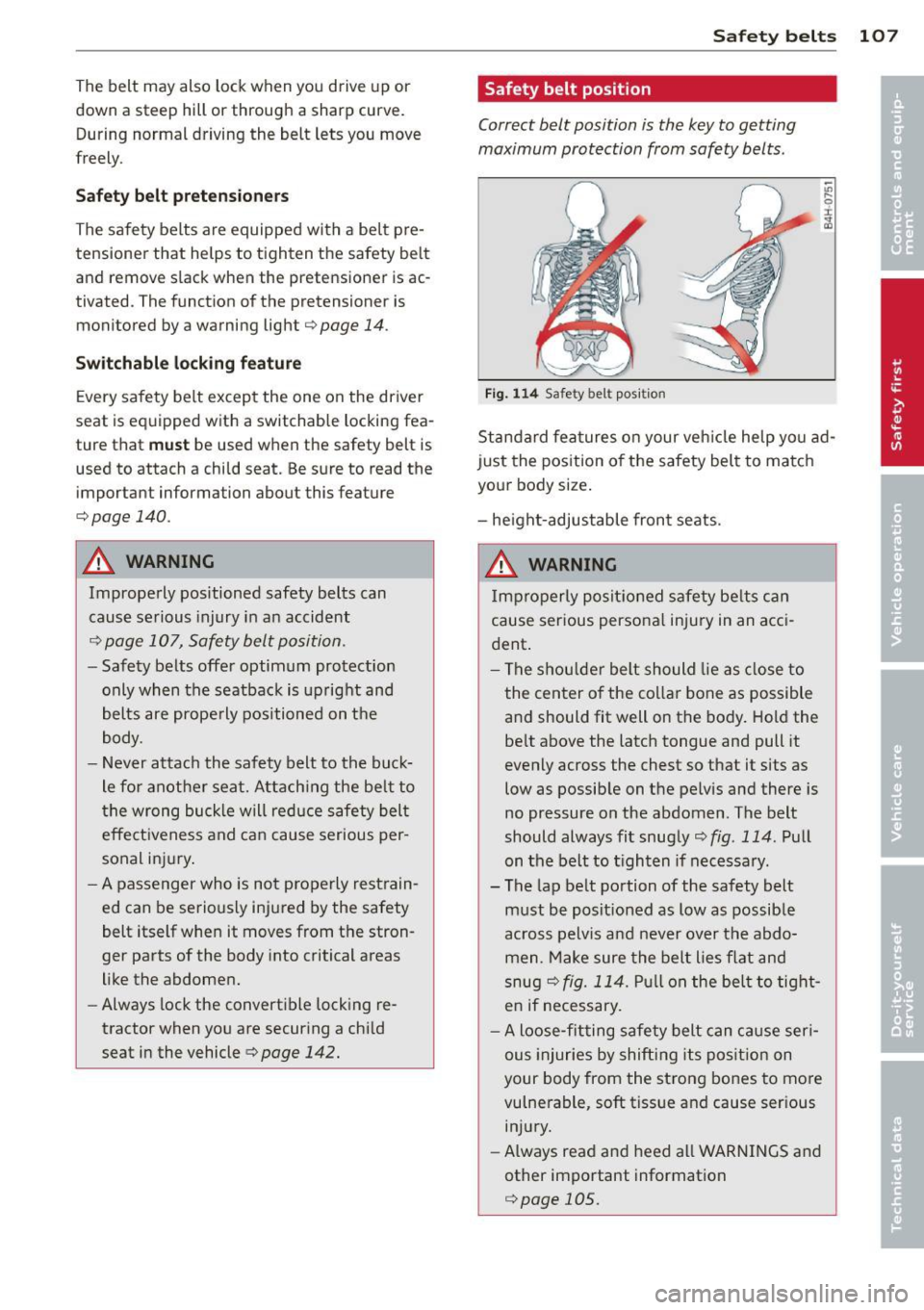
The belt may also lock when you drive up or
down a steep hill or through a sharp curve.
During normal driving the belt lets you move
freely .
Safety be lt pretensioners
The safety belts are equipped with a belt pre
tensioner that helps to tighten the safety belt
and remove slack when the pretensioner is ac
tivated . The function of the pretensione r is
monitored by a warning light ¢
page 14.
Switchable locking feature
Every safety belt except the one on the driver
seat is equipped with a switchable locking fea
ture that
must be used when the safety belt is
used to attach a child seat. Be sure to read the important information about this feature
¢page 140.
A WARNING
Improperly positioned safety belts can
cause serious injury in an accident
¢ page 107, Safety belt position .
-Safety belts offer optimum protection
only when the seatback is upright and
belts are properly positioned on the
body.
-
- Never attach the safety belt to the buck
le for another seat. Attaching the belt to
the wrong buckle will reduce safety belt
effect iveness and can cause serious per
sonal injury.
- A passenger who is not properly restrain
ed can be seriously injured by the safety
belt itself when it moves from the stron
ger parts of the body into critical areas
like the abdomen.
- Always lock the convertible locking re
tractor when you are securing a child
seat in the vehicle
r:::> page 142.
Safety belts 107
Safety belt position
Correct belt position is the key to getting
maximum protection from safety belts .
Fig. 114 Safety belt position
;;;
9 r ., a,
Standard features on your vehicle help you ad
just the position of the safety belt to match
your body size.
- height-adjustable front seats.
A WARNING
Improperly positioned safety belts can
cause serious personal injury in an acci
dent.
-
- The shoulder belt should lie as close to
the center of the collar bone as possible
and should fit well on the body. Hold the
belt above the latch tongue and pull it
evenly across the chest so that it sits as
low as possible on the pelvis and there is
no pressure on the abdomen . The belt
should always fit snugly
r:::> fig . 114. Pull
on the belt to tighten if necessary.
- The lap belt portion of the safety belt
must be positioned as low as possible
across pelvis and never over the abdo
men . Make sure the belt lies flat and
snug ¢
fig. 114. Pull on the belt to tight
en if necessary.
- A loose-fitting safety belt can cause seri
ous injuries by shifting its position on
your body from the strong bones to more
vulnerable, soft tissue and cause serious injury.
- Always read and heed all WARNINGS and
other important information
r:::> page 105.
Page 110 of 244
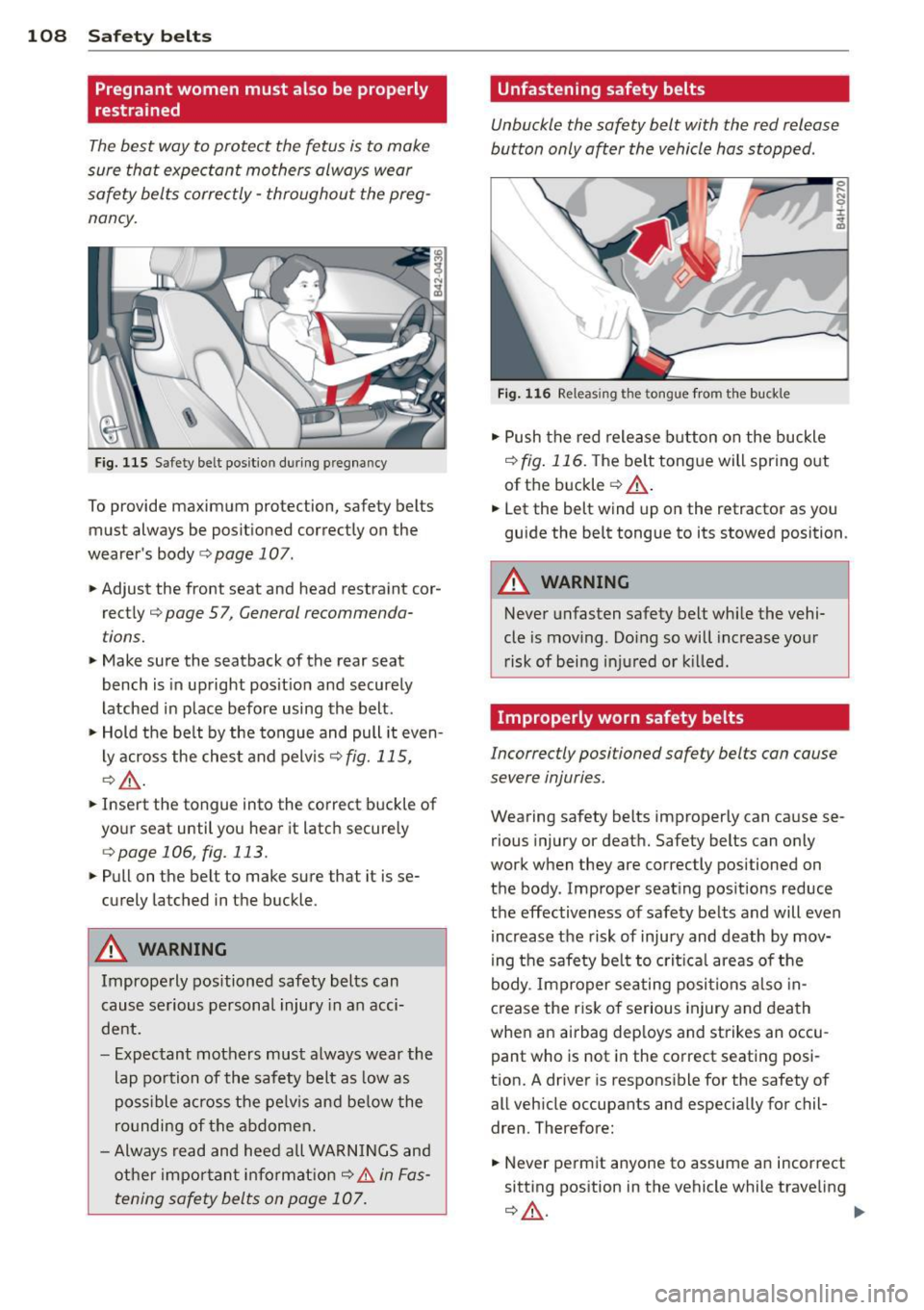
108 Safet y belt s
Pregnant women must also be properly
restrained
The best way to protect the fetus is to make
sure that expectant mothers always wear
safety belts correctly -throughout the preg
nancy.
Fig . 115 Safety be lt pos it io n dur ing p regnancy
To provide maximum prote ction , safety belts
must always be po sitioned correctly on the
wearer's body
c> page 107 .
• Adjust the front seat and head restraint cor
rect ly
c> page 5 7 , General recommenda
tions.
• Make sure the seatback of the rear seat
bench is in up right posit io n and securely
latched in p lace before using the b elt .
• Hold the be lt by the tongue and pull it even
l y across the ches t and pelvis
c> fig. 115,
c>,& .
• Inse rt the tongue into the correct buckle of
yo ur seat until you hear it latc h securely
c> page 106 , fig . 113.
• Pullon the belt to make sure that it is se
curely latched in t he buckle .
A WARNING
Imprope rly positioned safety belts can
cause se rious personal injury in an acci
dent.
-
- E xpec tant mothers must a lways wear the
lap po rtion of the safety b elt as low as
poss ible ac ross the pe lv is and be low the
ro unding of the abdome n.
- Always read and heed all WARN INGS and
ot her impo rtan t info rma tion
c> .&. in Fas
tening safety belts on page 107.
Unfastening safety belts
Unbuckle the safety belt with the red release
button only a~er the vehicle has stopped .
,,
}_
Fig . 11 6 Releas ing the ton gu e from the buc kle
• Push the red release b utton on the buckle
c> fig . 116. T he be lt tongue will spring out
of t he b uckle
c> ,& .
N 0 ;c
a1i
• Let the belt wind up on the retractor as you
guide the belt tongue to its stowed position .
A WARNING
-
Never unfasten safety belt whi le the vehi-
cle is mov ing . Do ing so will increase yo ur
r isk of being i njured o r kill ed .
Improperly worn safety belts
Incorrectly positioned safety belts can cause
severe injuries.
Wearing safety belts improper ly can ca use se
rious injury or deat h. Safety belts can only
work when they are correc tly positioned on
the body . Improper seat ing positions reduce
the effectiveness of safety be lts and will even
increase the risk of inju ry and death by mov
ing the safety be lt to crit ical areas o f the
body . Imp roper seati ng po siti ons also in
crease the risk of serious injury and death
whe n an a irbag dep loys and strikes an occu
pant who is not in the co rrect seating posi
t ion. A driver is respons ible for the safety of
all veh icle occupants and especially for chil
dren . There fore:
• Never pe rm it anyone to assume an incorrect
sitt ing position in the vehicle while trave ling
c> ,& . ~